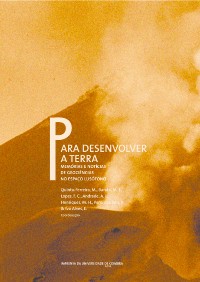Please use this identifier to cite or link to this item:
https://hdl.handle.net/10316.2/31418| DC Field | Value | Language |
|---|---|---|
| dc.contributor.author | Cruz, R. C. | |
| dc.contributor.author | Rocha, J. M. | |
| dc.contributor.author | Silveira, G. L. | |
| dc.contributor.author | Cruz, J. C. | |
| dc.contributor.author | Oliveira, S. C. Assis de | |
| dc.date.accessioned | 2014-06-20T09:14:36Z | |
| dc.date.accessioned | 2020-09-18T17:20:15Z | - |
| dc.date.available | 2014-06-20T09:14:36Z | |
| dc.date.available | 2020-09-18T17:20:15Z | - |
| dc.date.issued | 2012 | - |
| dc.identifier.isbn | 978-989-26-0531-9 (PDF) | |
| dc.identifier.uri | https://hdl.handle.net/10316.2/31418 | - |
| dc.description.abstract | This article seeks to reconstruct the conceptual history of environmental fragility analysis, since its origin in studies of geomorphology, until its update based on the concepts of total human ecosystem (THE) and stability of systems in the wake of Landscape Ecology developments. Following, we discuss the implications of this conceptual evolution in the approach of Integrated Environmental Assessment (IEA), taking as case study the application of IEA in the environmental planning of watersheds and their conflicts with the irrigation and generation of electricity sector policies. It discusses the limits of inclusion of institutional indicators in the models of IEA and how it should be understood as a process, going through phases of fragility environmental analysis, where the object of study, the THE, through analysis of different scenarios of human interventions and arriving in the analysis of the consequences of different scenarios for decision making. We alert about the risk of internalization of intra and inter‑institutional conflicts in the models, which can lead to weakening of the negotiation process that should exist between different institutions and community, strengthening the technocracy and the possible deepening of the conflict, with damages to quality of life and sustainability. | eng |
| dc.description.abstract | Neste artigo procura‑se reconstruir a história conceitual da análise de fragilidades ambientais, desde a sua origem nos estudos da geomorfologia, até a sua atualização com base nos conceitos de ecossistema total humano (ETH) e de estabilidade de sistemas, na esteira da evolução da Ecologia de Paisagem. Na sequência, se discutem as implicações desta evolução conceitual na abordagem da Avaliação Ambiental Integrada (AAI), tomando‑se como estudo de caso a aplicação da AAI no planejamento ambiental de bacias hidrográficas e seus conflitos com as políticas setoriais de irrigação e de geração de energia elétrica. Discute‑se os limites da inserção de indicadores institucionais nos modelos de AAI e como esta deve ser entendida como processo, passando por fases de análise de fragilidades ambientais, tendo como objeto de estudo o ETH, considerando a análise de diferentes cenários de intervenções antrópicas e chegando na análise das consequências de diferentes cenários de tomada de decisões. Alerta‑se quanto ao risco da internalização de conflitos intra e interinstitucionais nos modelos, que pode levar ao enfraquecimento do processo de negociação que deve haver entre os diferentes atores institucionais e comunitários, ao fortalecimento da tecnocracia e ao possível aprofundamento dos conflitos, com prejuízos à qualidade de vida e à sustentabilidade. | por |
| dc.language.iso | por | - |
| dc.publisher | Imprensa da Universidade de Coimbra | por |
| dc.relation.ispartof | http://hdl.handle.net/10316.2/24404 | por |
| dc.rights | open access | - |
| dc.subject | Integrated environmental assessment | eng |
| dc.subject | Environmental fragility | eng |
| dc.subject | Stability | eng |
| dc.subject | Sustainability | eng |
| dc.subject | Avaliação ambiental integrada | por |
| dc.subject | Fragilidades ambientais | por |
| dc.subject | Estabilidade | por |
| dc.subject | Sustentabilidade | por |
| dc.title | Uma análise crítica dos conceitos de análise de fragilidades ambientais e de avaliação ambiental integrada | por |
| dc.title.alternative | A critical analysis of the concepts of environmental fragility analysis and integrated environmental assessment | eng |
| dc.type | bookPart | por |
| uc.publication.firstPage | 45 | - |
| uc.publication.lastPage | 54 | - |
| uc.publication.location | Coimbra | por |
| dc.identifier.doi | 10.14195/978-989-26-0531-9_4 | - |
| uc.publication.digCollection | PB | por |
| uc.publication.orderno | 4 | - |
| uc.publication.area | Ciências Naturais | por |
| uc.publication.bookTitle | Para desenvolver a Terra: memórias e notícias de Geociências no espaço lusófono | - |
| uc.publication.manifest | https://dl.uc.pt/json/iiif/10316.2/31418/218952/manifest?manifest=/json/iiif/10316.2/31418/218952/manifest | - |
| uc.publication.thumbnail | https://dl.uc.pt/retrieve/11298005 | - |
| uc.publication.parentItemId | 52112 | - |
| uc.itemId | 71932 | - |
| item.fulltext | With Fulltext | - |
| item.grantfulltext | open | - |
| Appears in Collections: | Para desenvolver a Terra: memórias e notícias de Geociências no espaço lusófono | |
Files in This Item:
| File | Description | Size | Format | |
|---|---|---|---|---|
| 4-para_desenvolver_a_terra_artigo.pdf | 750.66 kB | Adobe PDF |  |
Items in DSpace are protected by copyright, with all rights reserved, unless otherwise indicated.
